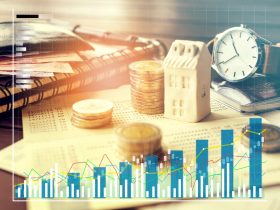The Treasury Market vs. the Equity Market
The Economy (SPY or S&P 500) represents the real economy, which is a Coincident Indicator.
The coincident indicator is a combination of the real (inflation adjusted) Gross Domestic Product [GDP] (or the real Domestic Income [GDI]) and the Labor Market. The labor market components are measured by employment, real earnings, average working hours worked in manufacturing.
The Stock Market and the (Short-Term) Treasury Market together lead the coincident indicator roughly six months, so we call them as Leading Indicators.
There are so many leading indicators; Long -terms, intermediate terms, or short terms. Most leading indicators are financial indicators because they do not reflect various goods manufacturing activities associated with the labor market. They carry over by prices, yields, rates, earnings, profits or losses, and so on. Therefore, they fluctuate widely than the coincident indicators.
Monday (Sep 25) the major indices rose, but the complexion of things beneath the index surface showed an otherwise: Long-term rates continued to rise. The major indices nonetheless closed near their highs, somewhat passively.
The 10-yr note yield jumped 10% to 4.54%, which is its highest level in nearly 16 years. Equities took that move in stride, though, after an initial selling off. The 2-yr note yield was unchanged at 5.12%. As a result, the inverted rates became much easier, shrinking to -0.58% from -0.68%.
Monday the Treasury market made an important turning point of a reversing course of the highly inverted yields, not reducing the yield of a short end (i.e., 2-yr), but raising the yield of the long end (i.e., 10-yr). Ironically, the traditionally passive Treasury market started leading the historically active equity market.
As Reported:
“[Monday (Sep 25)] Stocks moved somewhat lower at the open, pressured by the jump in rates and carryover downside momentum after last week’s losses. Things turned around quickly, though, and the major indices bounced off their lows, helped by a reversal in the mega cap stocks. The index bounce also coincided with the S&P 500 slipping below an initial support level at 4,305, which attracted some overdue buying interest amid a sense that stocks were short term oversold.
The market-cap weighted S&P 500 rose 0.4% and Vanguard Mega Cap Growth ETF (MGK) rose 0.5%. With today’s gains, however, the S&P 500, Nasdaq, and Russell 2000 are still down 3.8%, 5.4%, and 6.1%, respectively, for the month. “ ( source)
The leading role of the Treasury market in particular, the Bond market in general, is not unusual, but is a norm: The size of the Bond market is much Bigger than the Stock (or Equity) market: The former has been steady while the latter have been volatile.
Therefore, most investors pay all their attention on the stock market, but a long-term direction of the stock market basically depends on the bond market. This week happened to be a juncture of a critical moment of an adjustment process of the transitory inversion of the treasury yield curve in a couple of years.
The Market Perspective In 2023 and Beyond
Tuesday (Sep 26) the market slumped a bit. The market outlook in the coming months, however, seems to be bright rather than gloom. On top of the turnaround of the Treasury market, we have several optimistic data points as:
1) The U.S. Economy is predicted by the Federal Reserve [Fed]: The Atlanta Fed and the New York Fed.
2) The neutral rate might be higher than the Fed-estimated longer run rate (2.5%): In my view, it’s too pessimistic.
3) The performance of the top Artificial Intelligence [AI] companies such as Microsoft (MSFT), Apple (AAPL), Amazon (AMZN), Facebook (META), and Tesla (TSLA).
4) The negative impact of the oil-production cut by the OPEC and Russia, and the Union of Auto Workers [UAW] strike would be short-lived and abating in a few weeks.
5) The relationship between Inflation and the Economy on the Supply Shocks and Demand Push are opposite each other. The former case is Stagflation (the Economy slowdown and high inflation) while the latter case is that the Economy grows (not declines) with Inflation.
The reason is that Inflation Expectations work out differently: In the former (Supply Shock), inflation Expectations are poorly anchored, but in the latter (Demand Push), inflation Expectations are well anchored.
In Sum:
The current Super Bull Market, starting in March 2009, and the current Great Expansion, stating in June 2009, according to “Backing to the 2009 Origin”, would continue to run at least until the end of 2024.
Read the full article here












Leave a Reply